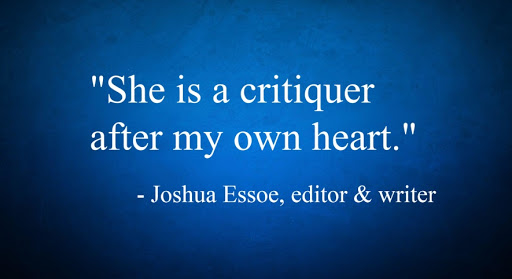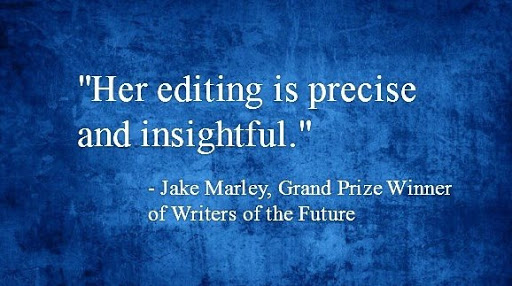Two years ago, I wrote this article called "Validating the Reader's Concerns." I felt pretty good about it at the time, but have since realized that validating the reader is an aspect of writing way bigger and more generalized than that article. In fact, I've realized that all successful writers do it--even if they don't know it.
But not all unpublished or beginning writers do. Which can be a setback.
How come no one ever talks about this?
Hopefully you are familiar with the term and concept of validation when it comes to day-to-day life. I am because, personally, validation used to be a huge stumbling block for me. But today, I don't want to think of validation as something that is good or bad for a person, but more of something that just is.
Here is the dictionary definition:
Recognition or affirmation that a person or their feelings or opinions are valid or worthwhile.
In writing, validation is part of context. It's validating the reader's experience--sort of like a reassurance that yes, I am aware of what you are thinking and experiencing as you read my passage.
I'm not talking about validating the reader's experience in his or her personal life, I'm talking about validating how they are reacting to your story.
In short, writers have to be mind readers.
To some extent.
It's like communicating with someone in real life--when you need to tell them something, and you already know how they are going to react, so you sit and think out how you are going to present it so they listen and understand you and what you want to convey
In storytelling, you don't need to validate everything, but the reality is, if you aren't validating what the reader is experiencing in some way, your story is broken. And 95% of the time, you need to be using validation.
Luckily most of us validate the reader without ever realizing it.
But there might be times where we don't and the story breaks--often it breaks by becoming unbelievable.
Just for example, let's say that Dumbledore dies in Harry Potter, and no one cries or shows any signs of real grief.
Huh?
Doesn't that seem weird? Especially when the characters and audience have spent so much time with him, getting to know him, and valuing him?
The reader will feel sad that Dumbledore died, or at the very least, expect some of the characters to feel sad.
But if that's not on the page, that feeling or thought isn't being validated, and there is going to be a problem. A few things might happen:
- The story will feel unbelievable.
- The reader will feel cheated.
- The audience loses trust in the writer
The audience can lose trust in the writer because they may start to think that the writer doesn't realize something is wrong in this part of the story when the audience does. Of course, this often isn't something the audience is consciously aware of--they may not be able to put it into language, but they'll know that something is wrong or broken. And that's when it swings back around and relates back to a lack of context.
The Dumbledore example is an obvious one, which is why I picked it first to illustrate the point. A lack of validation might sneak in your manuscript in other ways.
Let's go back to my example from my other post on validation: the fact that The Force Awakens includes essentially another "Death Star" (Starkiller Base).
This fact would have been hugely annoying to almost all audience members, had it not been validated.
I mean, really? Another Death Star?
That is how the audience would have responded
But the filmmakers validate and deal with how the audience would react.
Instead of ignoring the audience's concern about a third Death Star, they acknowledge it and even poke fun at it. Han says something like, "There's got to be a way to blow it up. There always is." And instead of being annoyed about this plotting and possibly laughing at it, we are laughing with it and the characters, and everything is fine. We accept the fact that this movie has another "Death Star" in it.
A lack of validation can show up almost whenever the thoughts or feelings of the audience aren't being affirmed in some way.
Let's go back to another example I've used in yet another post.
Mack shut the Hummer's hood. "Should be fine now," he said to John.
"Great. Thanks, Karl." John got in the driver's seat and stuck his key in the ignition. The Hummer roared to life.
John headed for the main road.
Why does John call Mack, Karl? We don't know. Not only do we have no context to interpret this exchange, but we have no validation that this exchange is even weird, which is what the audience is thinking. They might go back and look at it again, searching for some context, or at least some validation. But it's not there. Which leads to the conversation either feeling unbelievable, or to the audience questioning how much they can trust this writer to tell this story, since the writer is apparently unaware of this issue.
This leads me to two points:
- We need to validate what would come naturally (sadness over Dumbledore's death)
- And we need to validate anything improbable/unusual (like the third Death Star and John calling Mack, Karl)
Sometimes these things go together. For example, if no one is sad over Dumbledore's death (hard to believe, but hypothetically) then we need that fact validated by telling the reader why no one is sad.
In short, as I said before, we need to validate just about everything.
And naturally we will, most of the time.
But sometimes we as writers don't.
I think this probably happens most with speculative fiction and mystery plot lines, but it can also come from following the "Show, don't Tell" rule too religiously.
There isn't much to say about validating what is normal other than it should be there--it's expected to be there, so when it's not, something is probably broken. And you are probably doing this almost all the time naturally (if not, that's something to look at).
Just remember that the stronger the natural reaction to something, the more validation needs to be present. For example, having a line that simply says "Harry was sad" about Dumbledore isn't going to cut it for that situation. Because death causes such powerful emotional responses, we need more validation.
As for the other point, remember that the more unusual or atypical or unlikely something is, the more it needs validation.
The more unusual or atypical or unlikely something is, the more direct or louder validation it needs.
If Harry is looking at a picture of Dumbledore for the first time, and Dumbledore walks out of the frame, and Harry doesn't react, that's a problem. There's no validation.
So how do we validate the reader?
Let me count the ways.
Dialogue
Validation can simply come from character dialogue.Mack shut the Hummer's hood. "Should be fine now," he said to John.
"Great. Thanks, Karl." John got in the driver's seat.
"Did you just call me 'Karl'?" Mack asked.
John laughed. "Must be getting old. Sorry about that." He stuck his key in the ignition. The Hummer roared to life.
"Not a problem, Todd," Mack said.
"Don't tell that's going to be a 'thing' now."
"Of course not, Jacob."
John sighed, but it was a mock sigh.
He smiled as he headed for the main road.
See how the dialogue exchange validates that it was strange John called Mack the wrong name?
Validation.
Action
You can use characters' actions to validate something.Say that our protagonist, Mary, finally got the nerve to ask her crush out, and he rejected her. How should she be feeling right now? Well, I'll tell you that if she is in any way human, she should at least be feeling something, and since she's our protagonist, the reader should too.
"Sorry, but I'm not really interested," Chad said.
"Oh, well, see you around," Mary said.
As soon as she turned the corner and Chad was out of sight, she dropped her face into her hands. Peeking through her fingers, she beelined for the nearest restroom. Someone was in there, so she quickly opened the very first stall and locked herself in.
Her actions validate her feelings and the reader's concerns about the situation.
Feelings
You can validate something through a character's feelings, which can be written through dialogue or actions, or some other way, but I feel that it's still its own thing. The above example validated that Mary was feeling something through actions.Often we want to render feelings through action--or showing--but sometimes it's completely fine to just tell them. It depends on the situation. And then there are thoughts, which I'll get to in a second.
But my point of this section is that we can validate the reader by having a character feel a certain way.
For example, if something really strange just happened, you can validate that by having a character be surprised, curious, or mystified on the page.
Harry looked back at the trading card. The frame was empty.
"He's gone!" (Surprise)
Notice how Ron's response creates context to let the reader know that this is normal in the wizarding world.
"Well you can't expect him to hang around all day," Ron said.
Often this is why in many stories that deal with outlandish things, you need a character who is the skeptic. If you don't have one, it will be mighty hard to validate some of the audience's natural thoughts and feelings.
In the X-Files, Agent Scully needed to be skeptical in order to provide validation for the audience about Agent Mulder's paranormal theories. If she wasn't, the writer would have had to squeeze in another character to do the job, and if Chris Carter didn't do that, then the whole series would have had one validation problem after another. It would have been broken.
Which leads me to the next section.
Thoughts
Like feelings, thoughts can come through action and dialogue, or, in writing, as a thought itself.In the X-Files, it's important that Scully is always confronting Mulder and questioning his outlandish theories--it's important that her thought-process is almost always different than his. Likewise, on the few occasions where Scully does believe in something outlandish, Mulder then becomes her counterpoint in the framework of that particular episode.
Start looking for the skeptic in shows, even reality t.v. shows, and you'll start seeing them everywhere. It's because if no one asks those questions or thinks those things, then the story won't be able to fully validate the audience's thoughts and/or feelings, and may become unbelievable.
In writing, we use our viewpoint character's inner thoughts to validate the reader in addition to dialogue and action. This is especially important when dialogue and action aren't or can't validate.
For example, let's go back to Mary and Chad.
Maybe Mary wants no one to possibly know what she is actually thinking and feeling. The exchange might be like this.
"Sorry, but I'm not really interested," Chad said.
"Oh, it's fine. I don't mind," Mary said.
How could this be happening? she thought.
Keep in mind that what a character directly thinks in that moment though, depends on how raw the emotion is.
Since this is in the moment, Mary's feelings are going to be very raw, and probably not perfectly thought out. Later, maybe that night, we could have a line like this.
I was so embarrassed, Mary admitted to herself. Uugh, I hate rejection.
Negative Description
Negative description is when you explain or describe what something is not. The "negative" part doesn't refer to it being down and depressing, but is used more in the sense of "negative space"--what isn't there.Sometimes you can't validate the reader through any of the things listed above because there literally isn't anyone present in the scene who can validate it.
They might be atypical or unusual characters, or even creatures, who don't share the same thoughts or feelings about the moment that the average reader would have.
In my perpetual work-in-progress, I have a character who often doesn't think or respond to things in ways that most people would. I don't want to give a big background, because it's kind of complicated, but here's a small excerpt of when I've used this. My character, James, can be pretty atypical about situations.
Watch how he responds when learning about something supernatural for the first time, and how the text still validates what would be someone's typical response.
James stepped over animal dung. “This is a sacred place?”
Dustin tapped James’s arm. He shook his head and pointed to a knuckle of the rock formation that was lower than the others, about 25 feet up.
“Up there?” James asked.
Dustin nodded. “Not sacred in our plane, but in their plane,” he said. “That’s not the exact spot, alright? But that’s as close as you or I are gonna get to it, it’s in the rock.”
Someone else might have cocked a brow, rolled their eyes, or argued. James just said, “Okay.”
James isn't the type who would act skeptical in this situation, but perhaps most people would. Dustin is the one teaching James about the otherworldly, and he's not going to validate the strangeness either in this moment. So the only way to get in on the page is to use some negative description--what James doesn't do.
Stacking Validators
Often you'll be validating the reader in more than one way--in thoughts and feelings and dialogue and actions (negative description might be more rare). In fact, in some situations, it's required you do. The death of an important character, for example, probably needs to use almost all of the above to fully validate the audience. Combine multiple ways for most important moments.When Experiences Deviate
Keep in mind that sometimes the reader's experience deviates from the characters', but the reader still needs validation. It's just that while the character is feeling a particular emotion, the reader needs to see that emotion not so that it validates their feelings, but rather so it validates them intellectually--how and what they think that a character should be reacting and feelingValidation: Vital to a Satisfying Denouement
According to David Farland, one of the places in a story where validation is most important is in the denouement. After the climax, and the protagonist has triumphed, or, at least learned something valuable, the denouement needs to validate that. If it's a romance, validation might happen through a wedding. If it's an epic fantasy, it might be that the world is in peace and evil has been vanquished. If it's a detective story, the criminal is sentenced. If a character has gained wisdom, we see it validated--Scrooge donates money, goes to his nephew's party, buys dinner for Tiny Tim, wishes everyone a Merry Christmas.Often powerful denouements validate multiple points in multiple ways.
Related Posts
Validating the Reader's Concerns
Deviating the Reader's Experience from the Character's
Inconceivable! Dealing with Problems of Unbelievability
Context vs. Subtext (Context Should Not Become Subtext)
Raw vs. Subdued Emotion (Getting them Right in Your Story)
***




















0 comments:
Post a Comment
I love comments :)